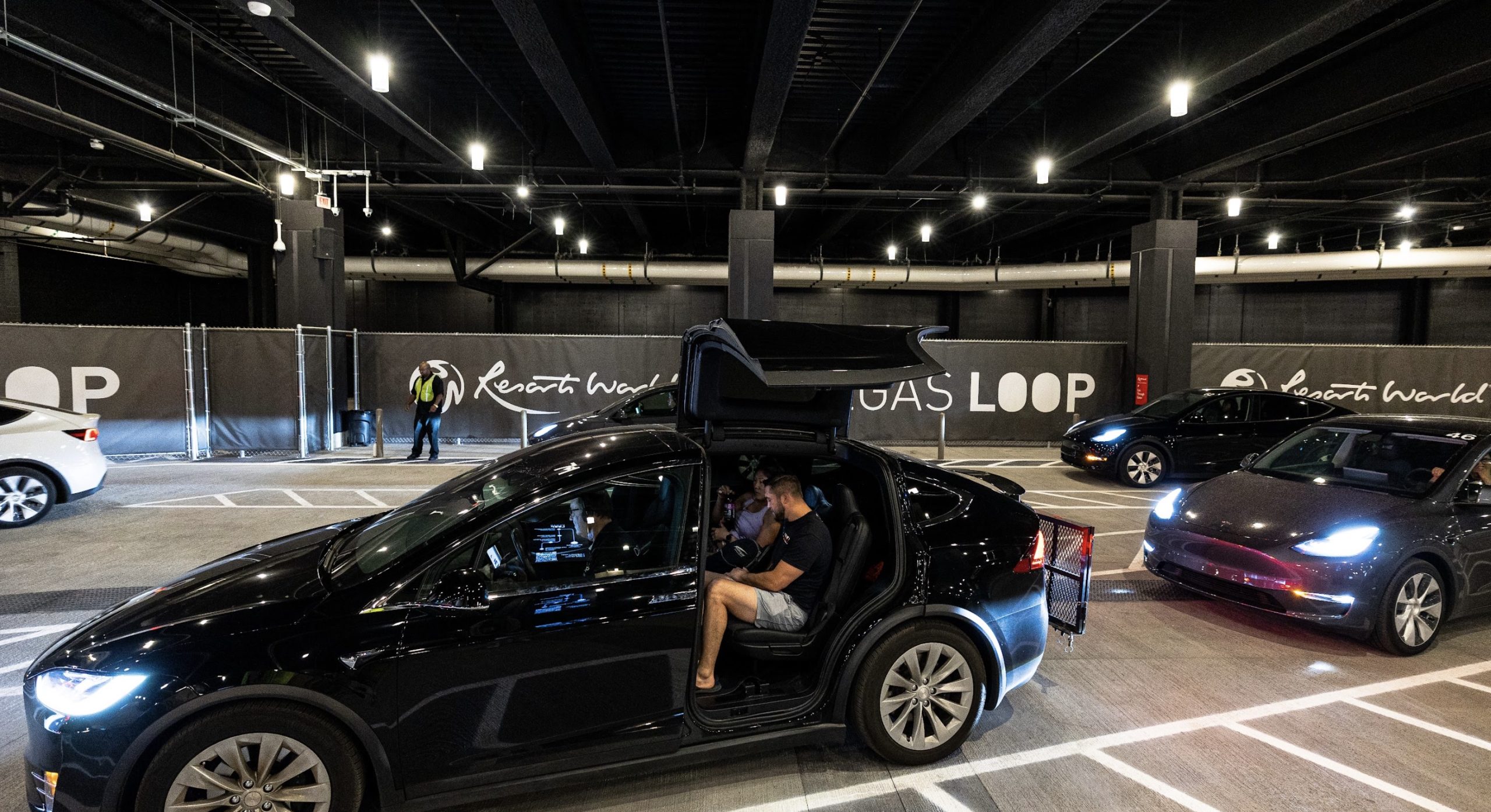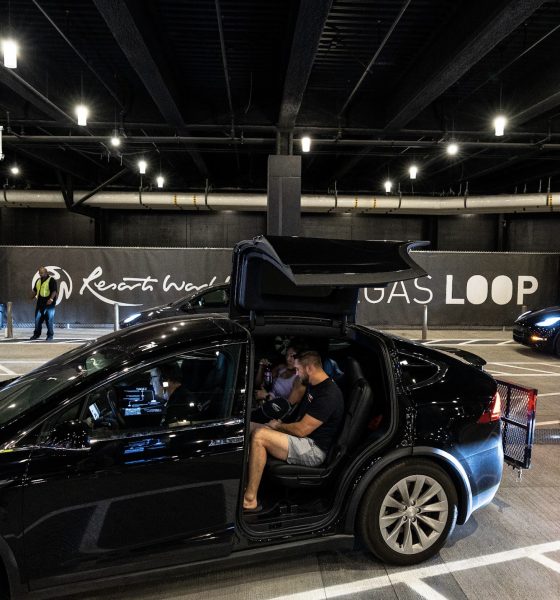

News
Tesla’s self-driving rollout strategy for Boring Co’s Las Vegas Loop gets teased
Steve Hill, president and CEO of the Las Vegas Convention and Visitors Authority (LVCVA), has shared some interesting tidbits about The Boring Company’s plans for the rollout of its self-driving Tesla fleet for its Las Vegas tunnels. Hill noted that while the entire system would likely not be self-driving by the end of this year, tests involving some autonomous cars should begin soon.
Initial renders of The Boring Company’s Loop system showed sleek tunnels with futuristic high-capacity vehicles traveling from one station to another autonomously. Yet for now, the Las Vegas Convention Center Loop and the Resorts World station operate using manually-driven Teslas that can hold about three passengers per vehicle. This has caught some mockery from Elon Musk critics.
Yet according to Hill, Tesla is continuing to work on its full self-driving system for the vehicles in the Las Vegas tunnels. In comments to the Las Vegas Review-Journal, Hill stated that he believes some of the Teslas being used in the Loop system would use the company’s full self-driving system sometime in the next fiscal year.
“We are certainly headed toward an autonomous system. We said at a (LVCVA) board meeting a month or two ago that our goal was, by the end of this fiscal year, to have some amount of autonomous driving happening in the system,” Hill said.
Elon Musk has mentioned recently that the Las Vegas Loop’s Tesla fleet may use FSD later this year. In this light, Hill noted that one vehicle at a time would be switched to use Tesla’s full self-driving system. And even at this point, they will still be using safety drivers until it can be proven that the vehicles can operate safely and adequately on their own. Only at this point will the drivers be removed.
“I don’t think we’ll be fully autonomous by the end of this calendar year, but we think we’re in a position to start testing autonomy relatively soon,” the LVCVA president said.
High-capacity vehicles for the Loop system will also be coming in the future. As it turned out, the advent of the pandemic during the buildout of the Las Vegas Convention Center Loop helped push officials to hold off on high-capacity vehicles. Teslas that carry three people are safer, after all, than a vehicle that carries 12 passengers during a pandemic.
But once the system expands and as FSD is rolled out to the Loop’s fleet, The Boring Company’s high-capacity vehicles are expected to be released. Hill noted that Elon Musk’s “Robovan” could be a good candidate for the Loop system’s high-capacity vehicles. Musk did note that Tesla’s Robovan will be highly configurable, so designing a version of the vehicle for The Boring Company’s Loop system should be no problem.
“You may have seen Elon tweeted out that he is working on a higher capacity vehicle, and it’s able to be modified for different applications. We think something along those lines, a version of that will be a part of this system,” Hill said.
For now, however, Hill told the Review-Journal that the current Tesla fleet deployed on the Las Vegas Convention Center and Vegas Loop is already useful. “You can use those higher-occupancy vehicles when you have a group of people who want to go from one place to the same place. Often folks don’t. The ability to have an individual car for people who want to go someplace different from where everybody else is going is an important aspect in the system. The higher occupancy vehicles will be helpful, too,” he said.
Don’t hesitate to contact us with news tips. Just send a message to simon@teslarati.com to give us a heads up.

News
Tesla FSD Supervised wins MotorTrend’s Best Driver Assistance Award
The decision marks a notable reversal for the publication from prior years, with judges citing major real-world improvements that pushed Tesla’s latest FSD software ahead of every competing ADAS system.

Tesla’s Full Self-Driving (Supervised) system has been named the best driver-assistance technology on the market, earning top honors at the 2026 MotorTrend Best Tech Awards.
The decision marks a notable reversal for the publication from prior years, with judges citing major real-world improvements that pushed Tesla’s latest FSD software ahead of every competing ADAS system. And it wasn’t even close.
MotorTrend reverses course
MotorTrend awarded Tesla FSD (Supervised) its 2026 Best Tech Driver Assistance title after extensive testing of the latest v14 software. The publication acknowledged that it had previously criticized earlier versions of FSD for erratic behavior and near-miss incidents, ultimately favoring rivals such as GM’s Super Cruise in earlier evaluations.
According to MotorTrend, the newest iteration of FSD resolved many of those shortcomings. Testers said v14 showed far smoother behavior in complex urban scenarios, including unprotected left turns, traffic circles, emergency vehicles, and dense city streets. While the system still requires constant driver supervision, judges concluded that no other advanced driver-assistance system currently matches its breadth of capability.
Unlike rival systems that rely on combinations of cameras, radar, lidar, and mapped highways, Tesla’s FSD operates using a camera-only approach and is capable of driving on city streets, rural roads, and freeways. MotorTrend stated that pure utility, the ability to handle nearly all road types, ultimately separated FSD from competitors like Ford BlueCruise, GM Super Cruise, and BMW’s Highway Assistant.
High cost and high capability
MotorTrend also addressed FSD’s pricing, which remains significantly higher than rival systems. Tesla currently charges $8,000 for a one-time purchase or $99 per month for a subscription, compared with far lower upfront and subscription costs from other automakers. The publication noted that the premium is justified given FSD’s unmatched scope and continuous software evolution.
Safety remained a central focus of the evaluation. While testers reported collision-free operation over thousands of miles, they noted ongoing concerns around FSD’s configurable driving modes, including options that allow aggressive driving and speeds beyond posted limits. MotorTrend emphasized that, like all Level 2 systems, FSD still depends on a fully attentive human driver at all times.
Despite those caveats, the publication concluded that Tesla’s rapid software progress fundamentally reshaped the competitive landscape. For drivers seeking the most capable hands-on driver-assistance system available today, MotorTrend concluded Tesla FSD (Supervised) now stands alone at the top.
News
Elon Musk’s Grokipedia surges to 5.6M articles, almost 79% of English Wikipedia
The explosive growth marks a major milestone for the AI-powered online encyclopedia, which was launched by Elon Musk’s xAI just months ago.

Elon Musk’s Grokipedia has grown to an impressive 5,615,201 articles as of today, closing in on 79% of the English Wikipedia’s current total of 7,119,376 articles.
The explosive growth marks a major milestone for the AI-powered online encyclopedia, which was launched by Elon Musk’s xAI just months ago. Needless to say, it would only be a matter of time before Grokipedia exceeds English Wikipedia in sheer volume.
Grokipedia’s rapid growth
xAI’s vision for Grokipedia emphasizes neutrality, while Grok’s reasoning capabilities allow for fast drafting and fact-checking. When Elon Musk announced the initiative in late September 2025, he noted that Grokipedia would be an improvement to Wikipedia because it would be designed to avoid bias.
At the time, Musk noted that Grokipedia “is a necessary step towards the xAI goal of understanding the Universe.”
Grokipedia was launched in late October, and while xAI was careful to list it only as Version 0.1 at the time, the online encyclopedia immediately earned praise. Wikipedia co-founder Larry Sanger highlighted the project’s innovative approach, noting how it leverages AI to fill knowledge gaps and enable rapid updates. Netizens also observed how Grokipedia tends to present articles in a more objective manner compared to Wikipedia, which is edited by humans.
Elon Musk’s ambitious plans
With 5,615,201 total articles, Grokipedia has now grown to almost 79% of English Wikipedia’s article base. This is incredibly quick, though Grokipedia remains text-only for now. xAI, for its part, has now updated the online encyclopedia’s iteration to v0.2.
Elon Musk has shared bold ideas for Grokipedia, including sending a record of the entire knowledge base to space as part of xAI’s mission to preserve and expand human understanding. At some point, Musk stated that Grokipedia will be renamed to Encyclopedia Galactica, and it will be sent to the cosmos.
“When Grokipedia is good enough (long way to go), we will change the name to Encyclopedia Galactica. It will be an open source distillation of all knowledge, including audio, images and video. Join xAI to help build the sci-fi version of the Library of Alexandria!” Musk wrote, adding in a later post that “Copies will be etched in stone and sent to the Moon, Mars and beyond. This time, it will not be lost.”
News
Tesla Model 3 becomes Netherlands’ best-selling used EV in 2025
More than one in ten second-hand electric cars sold in the country last year was a Tesla Model 3.

The Tesla Model 3 became the most popular used electric car in the Netherlands in 2025, cementing its dominance well beyond the country’s new-car market.
After years at the top of Dutch EV sales charts, the Model 3 now leads the country’s second-hand EV market by a wide margin, as record used-car purchases pushed electric vehicles further into the mainstream.
Model 3 takes a commanding lead
The Netherlands recorded more than 2.1 million used car sales last year, the highest level on record. Of those, roughly 4.8%, or about 102,000 vehicles, were electric. Within that growing segment, the Tesla Model 3 stood far ahead of its competitors.
In 2025 alone, 11,338 used Model 3s changed hands, giving the car an 11.1% share of the country’s entire used EV market. That means more than one in ten second-hand electric cars sold in the country last year was a Tesla Model 3, Auto Week Netherlands reported. The scale of its lead is striking: the gap between the Model 3 and the second-place finisher, the Volkswagen ID3, is more than 6,700 vehicles.
Rivals trail as residual values shape rankings
The Volkswagen ID.3 ranked a distant second, with 4,595 used units sold and a 4.5% market share. Close behind was the Audi e-tron, which placed third with 4,236 registrations. As noted by Auto Week Netherlands, relatively low residual values likely boosted the e-tron’s appeal in the used market, despite its higher original price.
Other strong performers included the Kia Niro, the Tesla Model Y, and the Hyundai Kona, highlighting continued demand for compact and midsize electric vehicles with proven range and reliability. No other model, however, came close to matching the Model 3’s scale or market presence.








